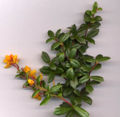Berberis darwinii: Difference between revisions
added my photos |
No edit summary |
||
| (One intermediate revision by one other user not shown) | |||
| Line 1: | Line 1: | ||
{{ | {{SPlantbox | ||
| | |familia=Berberidaceae | ||
| | |genus=Berberis | ||
| | |species=darwinii | ||
| | |taxo_author=Hook. | ||
| | |habit=shrub | ||
| | |Temp Metric=°F | ||
| | |jumpin=If this plant info box on watering; zones; height; etc. is mostly empty you can click on the edit tab and fill in the blanks! | ||
| | |image=Berberis darwinii-IMG 7835.JPG | ||
|image_width=180 | |||
|image_caption=Foliage and flowers | |||
| | |||
| | |||
}} | }} | ||
'''''Berberis darwinii''''' is a species of [[Berberis|barberry]], native to southern [[South America]] in southern [[Chile]] and adjacent southwestern [[Argentina]]. Common names include '''Darwin's Barberry''' and (Chilean Spanish) '''Michay'''. | '''''Berberis darwinii''''' is a species of [[Berberis|barberry]], native to southern [[South America]] in southern [[Chile]] and adjacent southwestern [[Argentina]]. Common names include '''Darwin's Barberry''' and (Chilean Spanish) '''Michay'''. | ||
| Line 23: | Line 18: | ||
It is a popular garden and hedging shrub in the [[British Isles]]. The [[Royal Horticultural Society]] has given it its [[Award of Garden Merit]]. The fruit is edible, though very acidic. | It is a popular garden and hedging shrub in the [[British Isles]]. The [[Royal Horticultural Society]] has given it its [[Award of Garden Merit]]. The fruit is edible, though very acidic. | ||
{{Inc| | |||
Berberis darwinii, Hook. Shrub, 1-3 ft.: branches brown, pubescent when young: Lvs. cuneate, obovate, spiny- toothed and usually 3-pointed at the apex, glossy dark green above, light green and lustrous beneath, ½-1 in. long: racemes 6-20-fld., longer than the Lvs., with the peduncle 2-4 in. long, pendulous; fls. orange-yellow, often reddish outside; style as long as the ovary: fr. dark purple. June; fr. Aug., Sept. Chile to Patagonia. | |||
}} | |||
==Cultivation== | |||
===Propagation=== | |||
===Pests and diseases=== | |||
==Varieties== | |||
==Gallery== | ==Gallery== | ||
<gallery> | |||
<gallery perrow=5> | |||
Image:Berberis darwinii-IMG 7832.JPG|Berberis darwinii | Image:Berberis darwinii-IMG 7832.JPG|Berberis darwinii | ||
Image:Berberis darwinii-IMG 7833.JPG|Berberis darwinii | Image:Berberis darwinii-IMG 7833.JPG|Berberis darwinii | ||
Image:Berberis darwinii shoot.jpg|Berberis darwinii | Image:Berberis darwinii shoot.jpg|Berberis darwinii | ||
</gallery> | </gallery> | ||
==References== | |||
<references/> | |||
*[[Standard Cyclopedia of Horticulture]], by L. H. Bailey, MacMillan Co., 1963 | |||
<!--- xxxxx *Flora: The Gardener's Bible, by Sean Hogan. Global Book Publishing, 2003. ISBN 0881925381 --> | |||
<!--- xxxxx *American Horticultural Society: A-Z Encyclopedia of Garden Plants, by Christopher Brickell, Judith D. Zuk. 1996. ISBN 0789419432 --> | |||
<!--- xxxxx *Sunset National Garden Book. Sunset Books, Inc., 1997. ISBN 0376038608 --> | |||
==External links== | ==External links== | ||
* | *{{wplink}} | ||
{{stub}} | |||
__NOTOC__ | |||
{{ | |||
Latest revision as of 01:39, 9 February 2010
| Berberis darwinii subsp. var. | ||||||||||||||||||||||||||||||||||||||||||||||||||||||||
|---|---|---|---|---|---|---|---|---|---|---|---|---|---|---|---|---|---|---|---|---|---|---|---|---|---|---|---|---|---|---|---|---|---|---|---|---|---|---|---|---|---|---|---|---|---|---|---|---|---|---|---|---|---|---|---|---|

|
|
| ||||||||||||||||||||||||||||||||||||||||||||||||||||||
| ||||||||||||||||||||||||||||||||||||||||||||||||||||||||
Berberis darwinii is a species of barberry, native to southern South America in southern Chile and adjacent southwestern Argentina. Common names include Darwin's Barberry and (Chilean Spanish) Michay.
It is an evergreen thorny shrub growing to 3-4 m tall, with dense branches from ground level. The leaves are small oval, 12-25 mm long and 5-12 mm broad, with a spiny margin; they are borne in clusters of 2-5 together, subtended by a three-branched spine 2-4 mm long. The flowers are orange, 4-5 mm long, produced in dense racemes 2-7 cm long in spring. The fruit is a small purple-black berry 4-7 mm diameter, ripening in summer.
It was discovered (for Western science) in South America in 1835 by Charles Darwin during the voyage of the 'Beagle'.
It is a popular garden and hedging shrub in the British Isles. The Royal Horticultural Society has given it its Award of Garden Merit. The fruit is edible, though very acidic.
| Standard Cyclopedia of Horticulture |
|---|
|
Berberis darwinii, Hook. Shrub, 1-3 ft.: branches brown, pubescent when young: Lvs. cuneate, obovate, spiny- toothed and usually 3-pointed at the apex, glossy dark green above, light green and lustrous beneath, ½-1 in. long: racemes 6-20-fld., longer than the Lvs., with the peduncle 2-4 in. long, pendulous; fls. orange-yellow, often reddish outside; style as long as the ovary: fr. dark purple. June; fr. Aug., Sept. Chile to Patagonia.
|
Cultivation
Propagation
Pests and diseases
Varieties
Gallery
-
Berberis darwinii
-
Berberis darwinii
-
Berberis darwinii
References
- Standard Cyclopedia of Horticulture, by L. H. Bailey, MacMillan Co., 1963
External links
- w:Berberis darwinii. Some of the material on this page may be from Wikipedia, under the Creative Commons license.
- Berberis darwinii QR Code (Size 50, 100, 200, 500)


